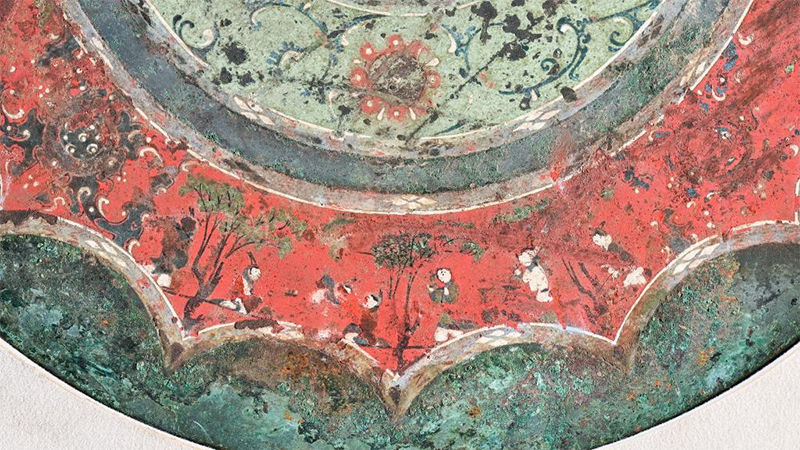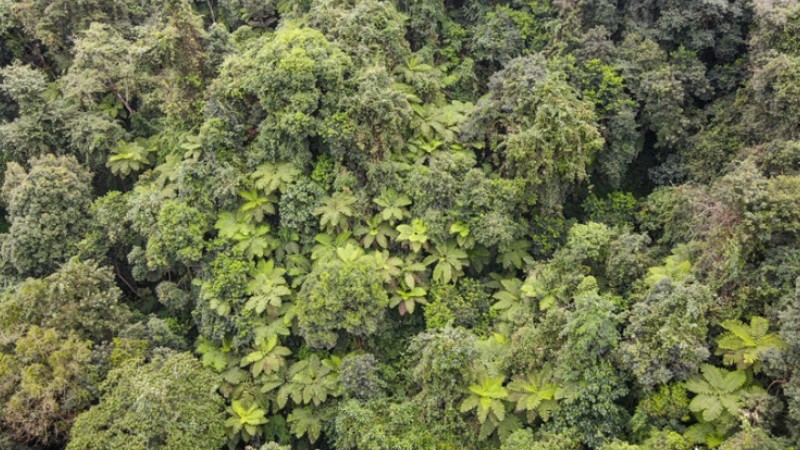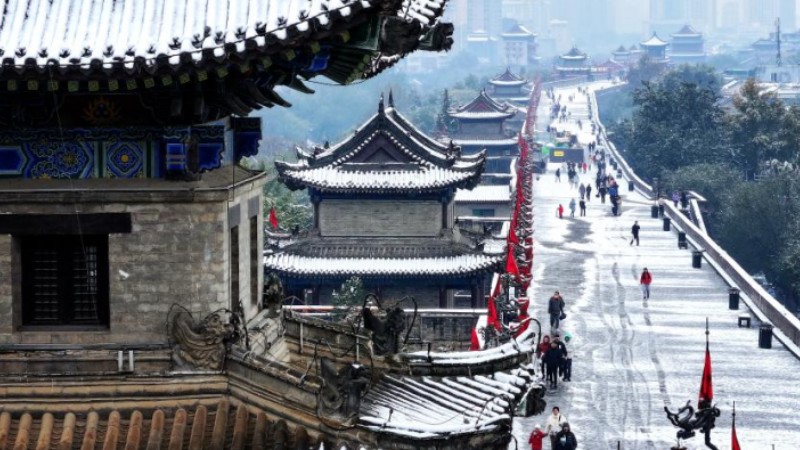Beijing Central Axis planned to recommend as China's 2024 world cultural heritage application project
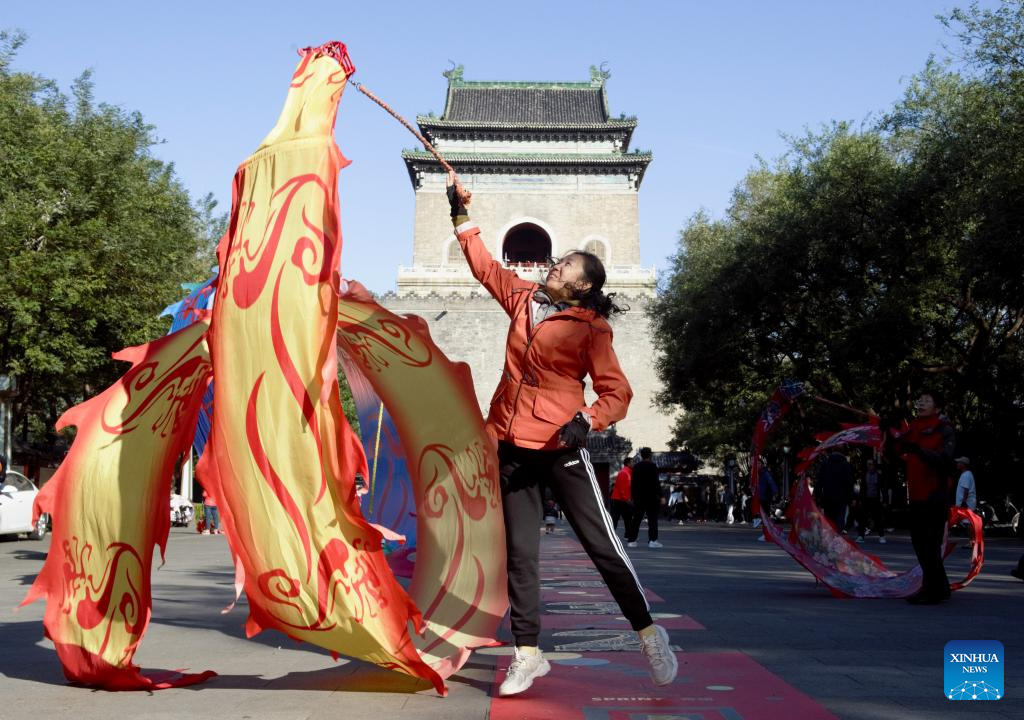
This photo taken on Nov. 7, 2023 shows a citizen exercising in front of the Bell Tower on the Beijing Central Axis in Beijing, capital of China. The Bell Tower, located in the northernmost part of the Beijing Central Axis, was the clock tolling center of Yuan, Ming and Qing dynasties and has a history of over 700 years. First created in the Yuan Dynasty (1271-1368), the Beijing Central Axis, or Zhongzhouxian, stretches 7.8 km between the Yongding Gate in the south of the city and the Drum Tower and Bell Tower in the north. Most of the major old-city buildings of Beijing sit along this axis.
Chinese authorities have planned to recommend the Beijing Central Axis as China's 2024 world cultural heritage application project. It was included on the preliminary list of China's world cultural heritage sites in 2012. (Xinhua/Luo Xiaoguang)

This photo taken on Nov. 6, 2023 shows a mythical creature sculpture on the Wanning Bridge, the oldest bridge on the Beijing Central Axis, in Beijing, capital of China. The bridge, having a history of over 700 years, is located on the crossing point of the Beijing Central Axis and the Yuhe River section of the Grand Canal. First created in the Yuan Dynasty (1271-1368), the Beijing Central Axis, or Zhongzhouxian, stretches 7.8 km between the Yongding Gate in the south of the city and the Drum Tower and Bell Tower in the north. Most of the major old-city buildings of Beijing sit along this axis.
Chinese authorities have planned to recommend the Beijing Central Axis as China's 2024 world cultural heritage application project. It was included on the preliminary list of China's world cultural heritage sites in 2012. (Xinhua/Cai Yang)

This photo taken on Sept. 29, 2023 shows the Tian'anmen Square on the Beijing Central Axis in Beijing, capital of China. First created in the Yuan Dynasty (1271-1368), the Beijing Central Axis, or Zhongzhouxian, stretches 7.8 km between the Yongding Gate in the south of the city and the Drum Tower and Bell Tower in the north. Most of the major old-city buildings of Beijing sit along this axis.
Chinese authorities have planned to recommend the Beijing Central Axis as China's 2024 world cultural heritage application project. It was included on the preliminary list of China's world cultural heritage sites in 2012. (Xinhua/Ren Chao)

This photo taken on Nov. 6, 2023 shows a woman walking on the Wanning Bridge, the oldest bridge on the Beijing Central Axis, in Beijing, capital of China. The bridge, having a history of over 700 years, is located on the crossing point of the Beijing Central Axis and the Yuhe River section of the Grand Canal. First created in the Yuan Dynasty (1271-1368), the Beijing Central Axis, or Zhongzhouxian, stretches 7.8 km between the Yongding Gate in the south of the city and the Drum Tower and Bell Tower in the north. Most of the major old-city buildings of Beijing sit along this axis.
Chinese authorities have planned to recommend the Beijing Central Axis as China's 2024 world cultural heritage application project. It was included on the preliminary list of China's world cultural heritage sites in 2012. (Xinhua/Cai Yang)

This photo taken on Nov. 6, 2023 shows the Yongding Gate on the southernmost part of the Beijing Central Axis in Beijing, capital of China. First created in the Yuan Dynasty (1271-1368), the Beijing Central Axis, or Zhongzhouxian, stretches 7.8 km between the Yongding Gate in the south of the city and the Drum Tower and Bell Tower in the north. Most of the major old-city buildings of Beijing sit along this axis.
Chinese authorities have planned to recommend the Beijing Central Axis as China's 2024 world cultural heritage application project. It was included on the preliminary list of China's world cultural heritage sites in 2012. (Xinhua/Li He)

This photo taken on Oct. 19, 2023 shows the Forbidden City, which was first built in 1406 and was listed as one of the world heritage sites by UNESCO in 1987, seen from the Jingshan Mountain on the Beijing Central Axis in Beijing, capital of China. First created in the Yuan Dynasty (1271-1368), the Beijing Central Axis, or Zhongzhouxian, stretches 7.8 km between the Yongding Gate in the south of the city and the Drum Tower and Bell Tower in the north. Most of the major old-city buildings of Beijing sit along this axis.
Chinese authorities have planned to recommend the Beijing Central Axis as China's 2024 world cultural heritage application project. It was included on the preliminary list of China's world cultural heritage sites in 2012. (Xinhua/Li Xin)
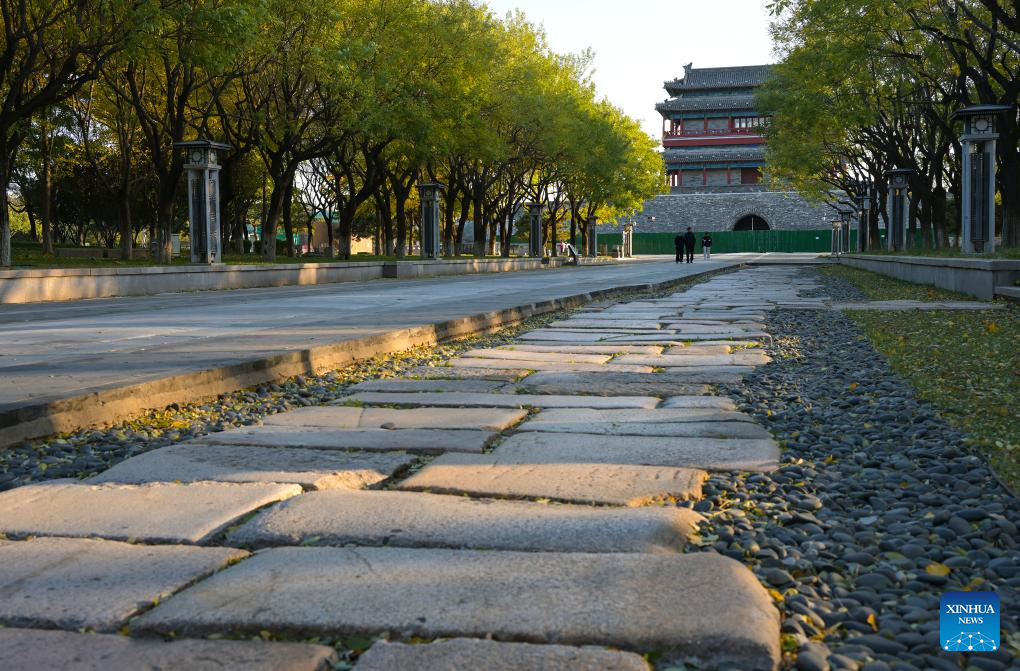
This photo taken on Nov. 6, 2023 shows an ancient road paved by stones, where the ancient emperors passed from the Forbidden City to the place of sacrifice, in the north of Yongding Gate on the southernmost part of the Beijing Central Axis in Beijing, capital of China. First created in the Yuan Dynasty (1271-1368), the Beijing Central Axis, or Zhongzhouxian, stretches 7.8 km between the Yongding Gate in the south of the city and the Drum Tower and Bell Tower in the north. Most of the major old-city buildings of Beijing sit along this axis.
Chinese authorities have planned to recommend the Beijing Central Axis as China's 2024 world cultural heritage application project. It was included on the preliminary list of China's world cultural heritage sites in 2012. (Xinhua/Li He)

This photo taken on Nov. 3, 2023 shows the Hall of Prayer for Good Harvests, or Qiniandian, in the Temple of Heaven, which was listed as one of the UNESCO world heritage sites in 1998, on the Beijing Central Axis in Beijing, capital of China. First created in the Yuan Dynasty (1271-1368), the Beijing Central Axis, or Zhongzhouxian, stretches 7.8 km between the Yongding Gate in the south of the city and the Drum Tower and Bell Tower in the north. Most of the major old-city buildings of Beijing sit along this axis.
Chinese authorities have planned to recommend the Beijing Central Axis as China's 2024 world cultural heritage application project. It was included on the preliminary list of China's world cultural heritage sites in 2012. (Xinhua/Mu Wenchun)

This photo taken on Oct. 22, 2023 shows people visiting the Hall of Prayer for Good Harvests, or Qiniandian, in the Temple of Heaven, which was listed as one of the UNESCO world heritage sites in 1998, on the Beijing Central Axis in Beijing, capital of China. First created in the Yuan Dynasty (1271-1368), the Beijing Central Axis, or Zhongzhouxian, stretches 7.8 km between the Yongding Gate in the south of the city and the Drum Tower and Bell Tower in the north. Most of the major old-city buildings of Beijing sit along this axis.
Chinese authorities have planned to recommend the Beijing Central Axis as China's 2024 world cultural heritage application project. It was included on the preliminary list of China's world cultural heritage sites in 2012. (Xinhua/Mu Wenchun)

This photo taken on Nov. 6, 2023 shows the Zhengyang Gate, or Qianmen Gate, which was listed as one of the protection units of key national cultural relics in 1988, on the Beijing Central Axis in Beijing, capital of China. First created in the Yuan Dynasty (1271-1368), the Beijing Central Axis, or Zhongzhouxian, stretches 7.8 km between the Yongding Gate in the south of the city and the Drum Tower and Bell Tower in the north. Most of the major old-city buildings of Beijing sit along this axis.
Chinese authorities have planned to recommend the Beijing Central Axis as China's 2024 world cultural heritage application project. It was included on the preliminary list of China's world cultural heritage sites in 2012. (Xinhua/Ju Huanzong)

This photo taken on Nov. 6, 2023 shows a corner of the Forbidden City, which was first built in 1406 and was listed as one of the world heritage sites by UNESCO in 1987, seen from the Jingshan Mountain on the Beijing Central Axis in Beijing, capital of China. First created in the Yuan Dynasty (1271-1368), the Beijing Central Axis, or Zhongzhouxian, stretches 7.8 km between the Yongding Gate in the south of the city and the Drum Tower and Bell Tower in the north. Most of the major old-city buildings of Beijing sit along this axis.
Chinese authorities have planned to recommend the Beijing Central Axis as China's 2024 world cultural heritage application project. It was included on the preliminary list of China's world cultural heritage sites in 2012. (Xinhua/Li Xin)
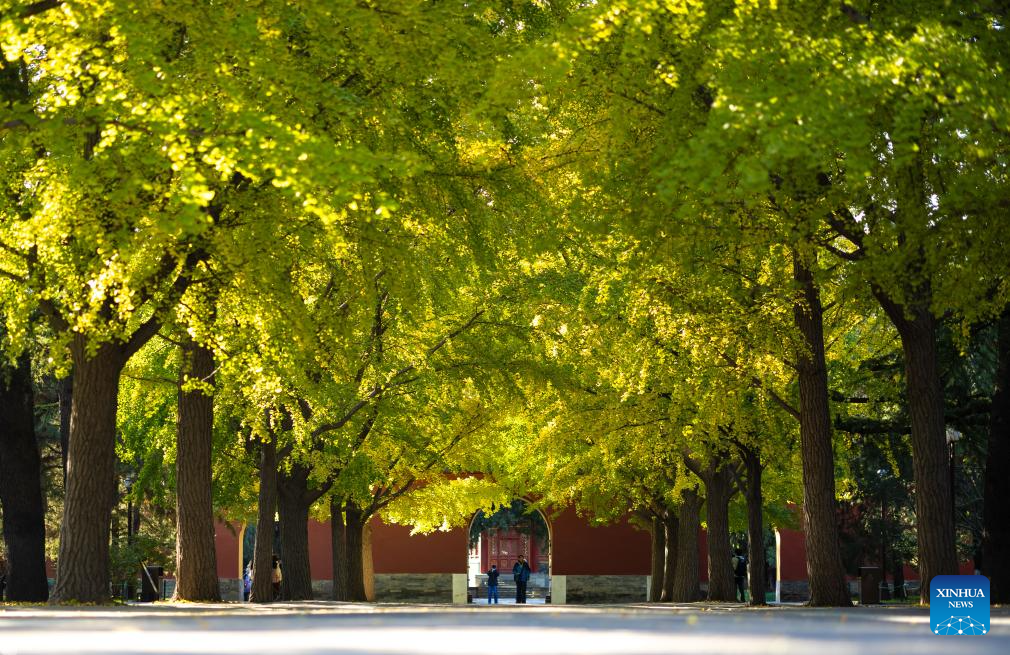
This photo taken on Nov. 7, 2023 shows people visiting the Beijing Zhongshan Park on the Beijing Central Axis in Beijing, capital of China. First created in the Yuan Dynasty (1271-1368), the Beijing Central Axis, or Zhongzhouxian, stretches 7.8 km between the Yongding Gate in the south of the city and the Drum Tower and Bell Tower in the north. Most of the major old-city buildings of Beijing sit along this axis.
Chinese authorities have planned to recommend the Beijing Central Axis as China's 2024 world cultural heritage application project. It was included on the preliminary list of China's world cultural heritage sites in 2012. (Xinhua/Li Jing)
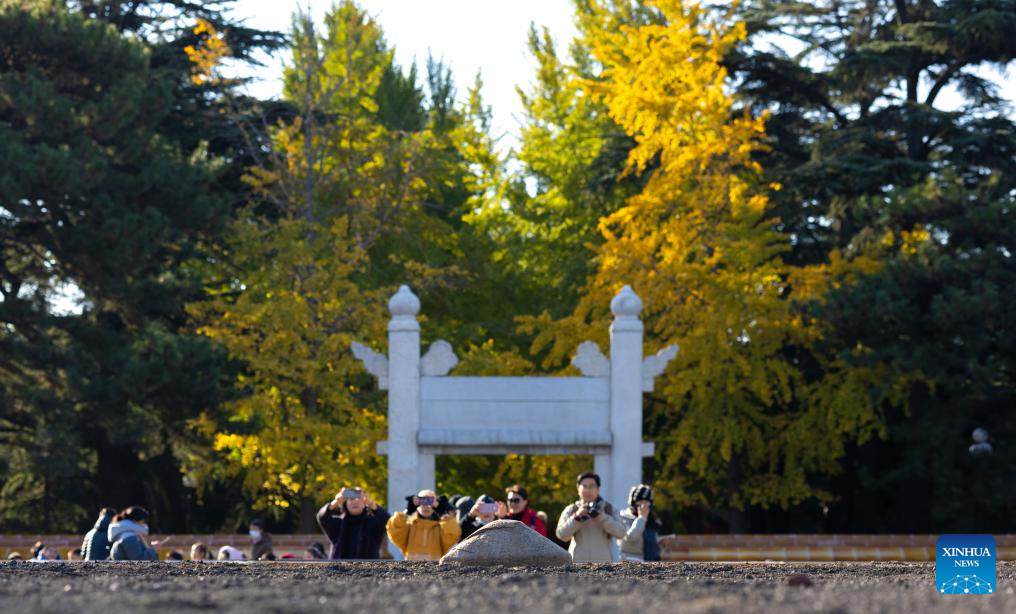
This photo taken on Nov. 7, 2023 shows people taking photos of the Altar of Land and Grain, where the ancient emperors offered sacrifice to the gods of land and grain, at the Beijing Zhongshan Park on the Beijing Central Axis in Beijing, capital of China. First created in the Yuan Dynasty (1271-1368), the Beijing Central Axis, or Zhongzhouxian, stretches 7.8 km between the Yongding Gate in the south of the city and the Drum Tower and Bell Tower in the north. Most of the major old-city buildings of Beijing sit along this axis.
Chinese authorities have planned to recommend the Beijing Central Axis as China's 2024 world cultural heritage application project. It was included on the preliminary list of China's world cultural heritage sites in 2012. (Xinhua/Li Jing)

This photo taken on Oct. 27, 2023 shows a turret of the Forbidden City on the Beijing Central Axis in Beijing, capital of China. First created in the Yuan Dynasty (1271-1368), the Beijing Central Axis, or Zhongzhouxian, stretches 7.8 km between the Yongding Gate in the south of the city and the Drum Tower and Bell Tower in the north. Most of the major old-city buildings of Beijing sit along this axis.
Chinese authorities have planned to recommend the Beijing Central Axis as China's 2024 world cultural heritage application project. It was included on the preliminary list of China's world cultural heritage sites in 2012. (Xinhua/Li Xin)
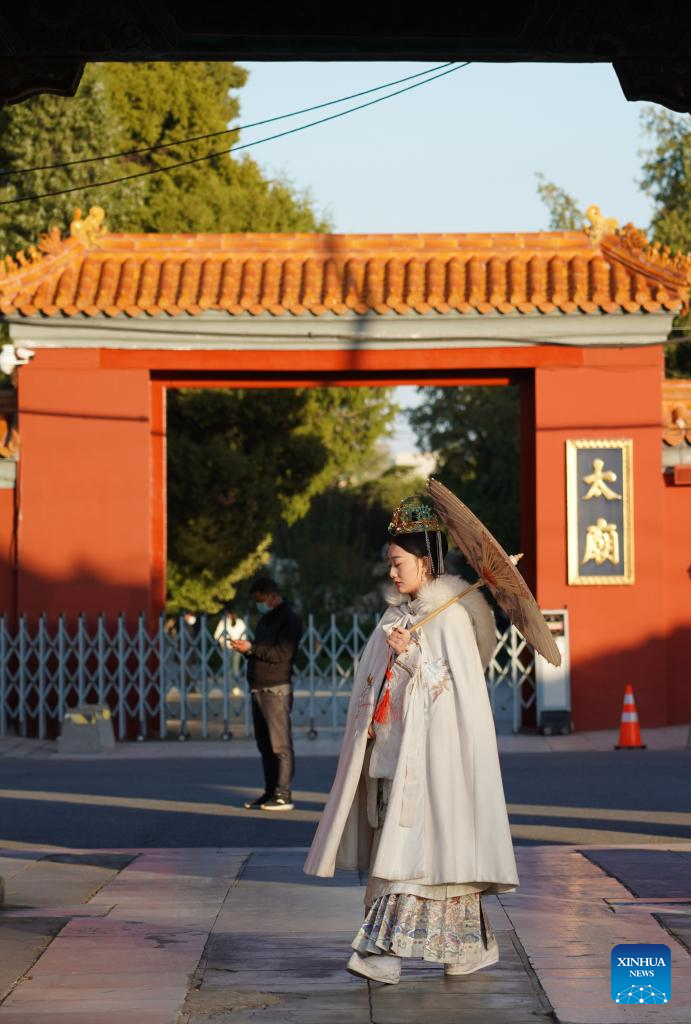
This photo taken on Nov. 6, 2023 shows a visitor passing by the west gate of the Imperial Ancestral Temple, which was built in 1420 for emperors of Ming and Qing dynasties to offer sacrifices to ancestors, on the Beijing Central Axis in Beijing, capital of China. First created in the Yuan Dynasty (1271-1368), the Beijing Central Axis, or Zhongzhouxian, stretches 7.8 km between the Yongding Gate in the south of the city and the Drum Tower and Bell Tower in the north. Most of the major old-city buildings of Beijing sit along this axis.
Chinese authorities have planned to recommend the Beijing Central Axis as China's 2024 world cultural heritage application project. It was included on the preliminary list of China's world cultural heritage sites in 2012. (Xinhua/Chen Zhonghao)
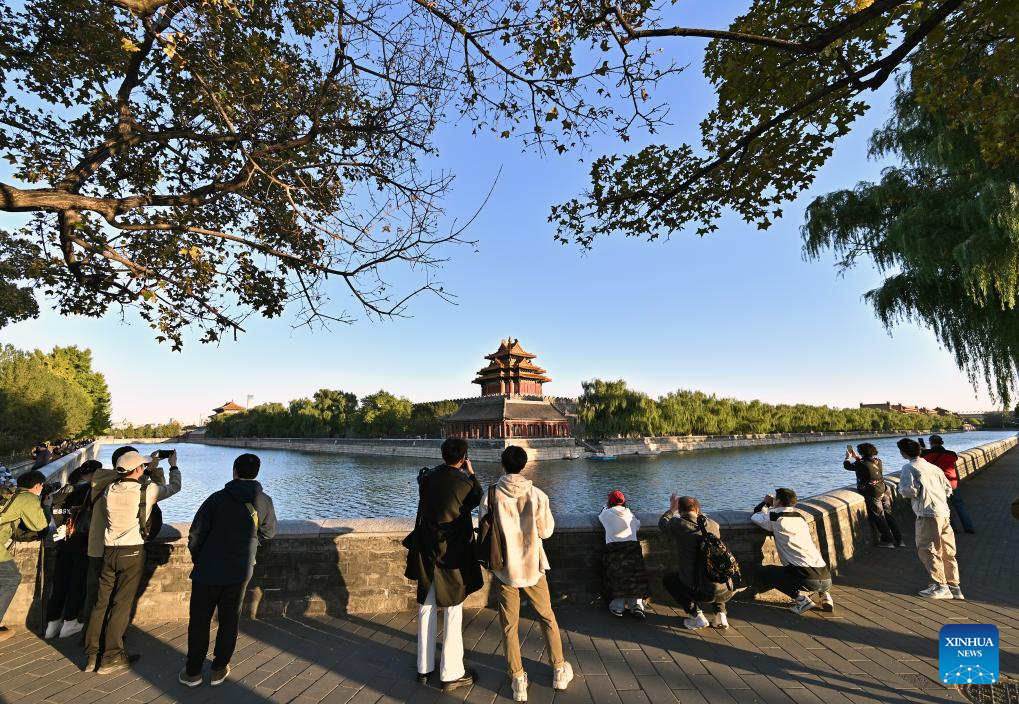
This photo taken on Oct. 20, 2023 shows people taking photos of a turret of the Forbidden City on the Beijing Central Axis in Beijing, capital of China. First created in the Yuan Dynasty (1271-1368), the Beijing Central Axis, or Zhongzhouxian, stretches 7.8 km between the Yongding Gate in the south of the city and the Drum Tower and Bell Tower in the north. Most of the major old-city buildings of Beijing sit along this axis.
Chinese authorities have planned to recommend the Beijing Central Axis as China's 2024 world cultural heritage application project. It was included on the preliminary list of China's world cultural heritage sites in 2012. (Xinhua/Li Xin)

This photo taken on Nov. 6, 2023 shows the Yongding Gate on the southernmost part of the Beijing Central Axis in Beijing, capital of China. First created in the Yuan Dynasty (1271-1368), the Beijing Central Axis, or Zhongzhouxian, stretches 7.8 km between the Yongding Gate in the south of the city and the Drum Tower and Bell Tower in the north. Most of the major old-city buildings of Beijing sit along this axis.
Chinese authorities have planned to recommend the Beijing Central Axis as China's 2024 world cultural heritage application project. It was included on the preliminary list of China's world cultural heritage sites in 2012. (Xinhua/Li He)
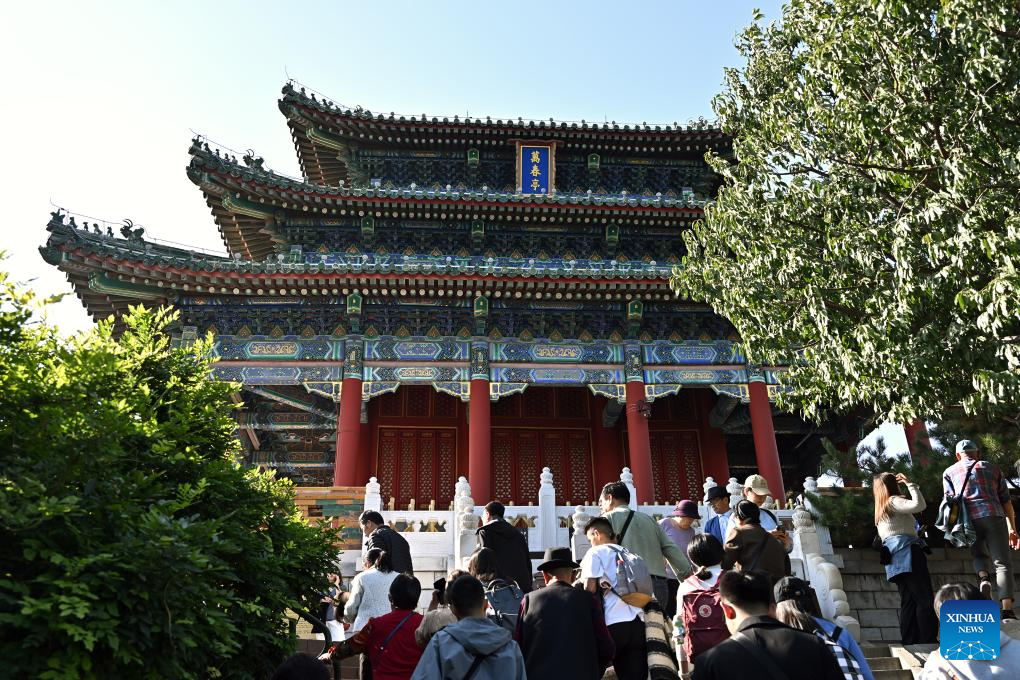
This photo taken on Oct. 27, 2023 shows the Wanchun pavilion on the mountain top of the Jingshan park on the Beijing Central Axis in Beijing, capital of China. First created in the Yuan Dynasty (1271-1368), the Beijing Central Axis, or Zhongzhouxian, stretches 7.8 km between the Yongding Gate in the south of the city and the Drum Tower and Bell Tower in the north. Most of the major old-city buildings of Beijing sit along this axis.
Chinese authorities have planned to recommend the Beijing Central Axis as China's 2024 world cultural heritage application project. It was included on the preliminary list of China's world cultural heritage sites in 2012. (Xinhua/Li Xin)

This photo taken on Nov. 6, 2023 shows the Forbidden City, which was first built in 1406 and was listed as one of the world heritage sites by UNESCO in 1987, seen from the Jingshan Mountain on the Beijing Central Axis in Beijing, capital of China. First created in the Yuan Dynasty (1271-1368), the Beijing Central Axis, or Zhongzhouxian, stretches 7.8 km between the Yongding Gate in the south of the city and the Drum Tower and Bell Tower in the north. Most of the major old-city buildings of Beijing sit along this axis.
Chinese authorities have planned to recommend the Beijing Central Axis as China's 2024 world cultural heritage application project. It was included on the preliminary list of China's world cultural heritage sites in 2012. (Xinhua/Li Xin)
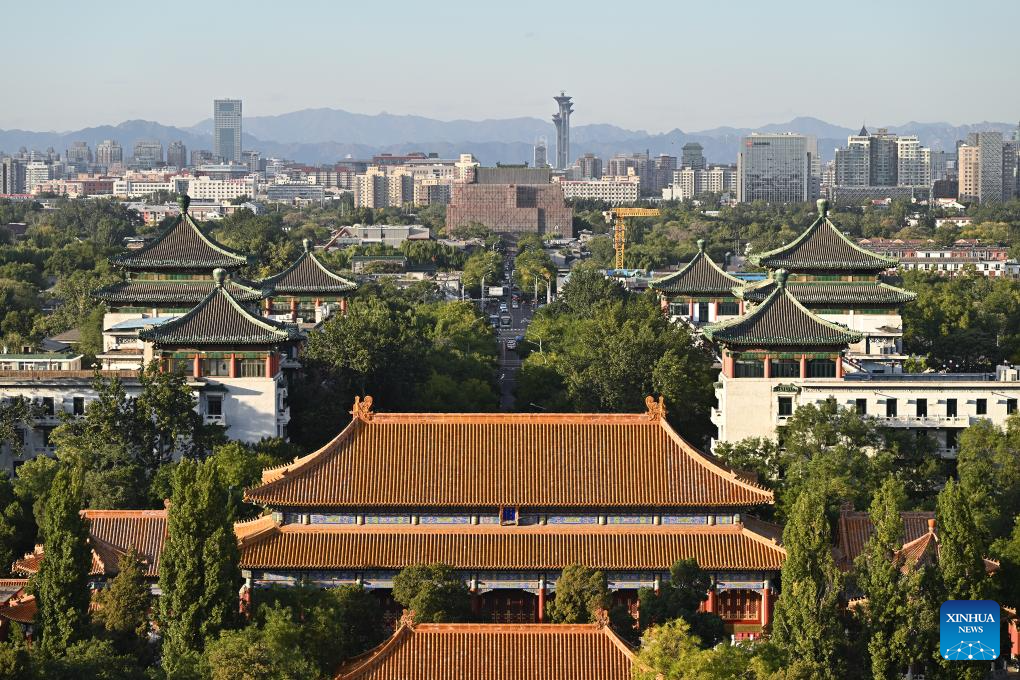
This photo taken on Oct. 19, 2023 shows the Drum Tower under maintenance seen from the Jingshan Mountain on the Beijing Central Axis in Beijing, capital of China. First created in the Yuan Dynasty (1271-1368), the Beijing Central Axis, or Zhongzhouxian, stretches 7.8 km between the Yongding Gate in the south of the city and the Drum Tower and Bell Tower in the north. Most of the major old-city buildings of Beijing sit along this axis.
Chinese authorities have planned to recommend the Beijing Central Axis as China's 2024 world cultural heritage application project. It was included on the preliminary list of China's world cultural heritage sites in 2012. (Xinhua/Li Xin)
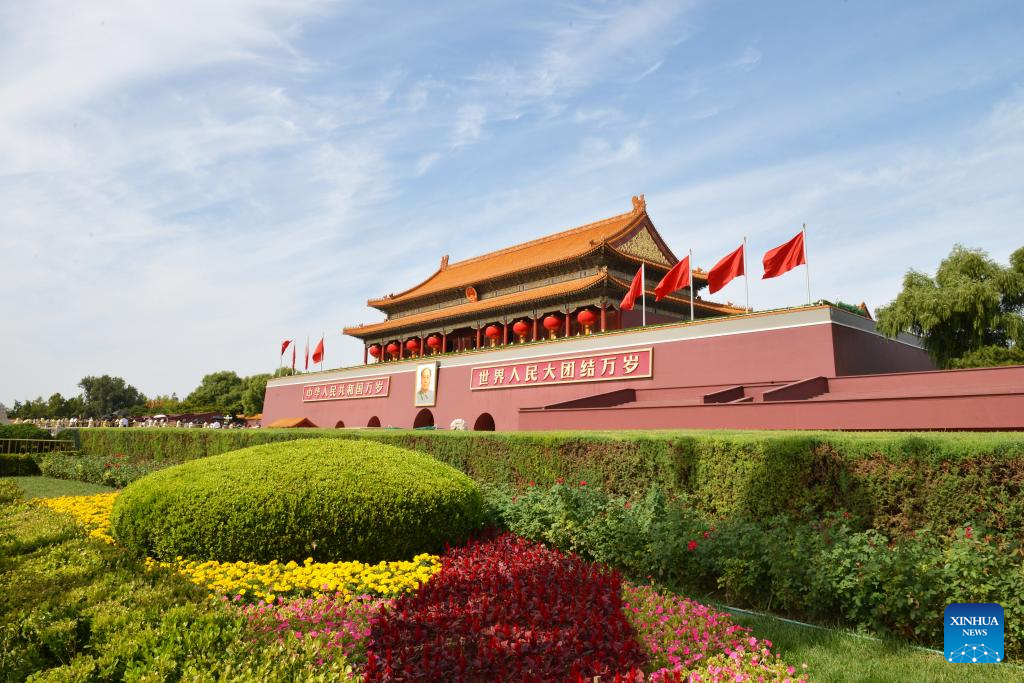
This photo taken on Oct. 6, 2023 shows the Tian'anmen Rostrum on the Beijing Central Axis in Beijing, capital of China. First created in the Yuan Dynasty (1271-1368), the Beijing Central Axis, or Zhongzhouxian, stretches 7.8 km between the Yongding Gate in the south of the city and the Drum Tower and Bell Tower in the north. Most of the major old-city buildings of Beijing sit along this axis.
Chinese authorities have planned to recommend the Beijing Central Axis as China's 2024 world cultural heritage application project. It was included on the preliminary list of China's world cultural heritage sites in 2012. (Xinhua/Ren Chao)
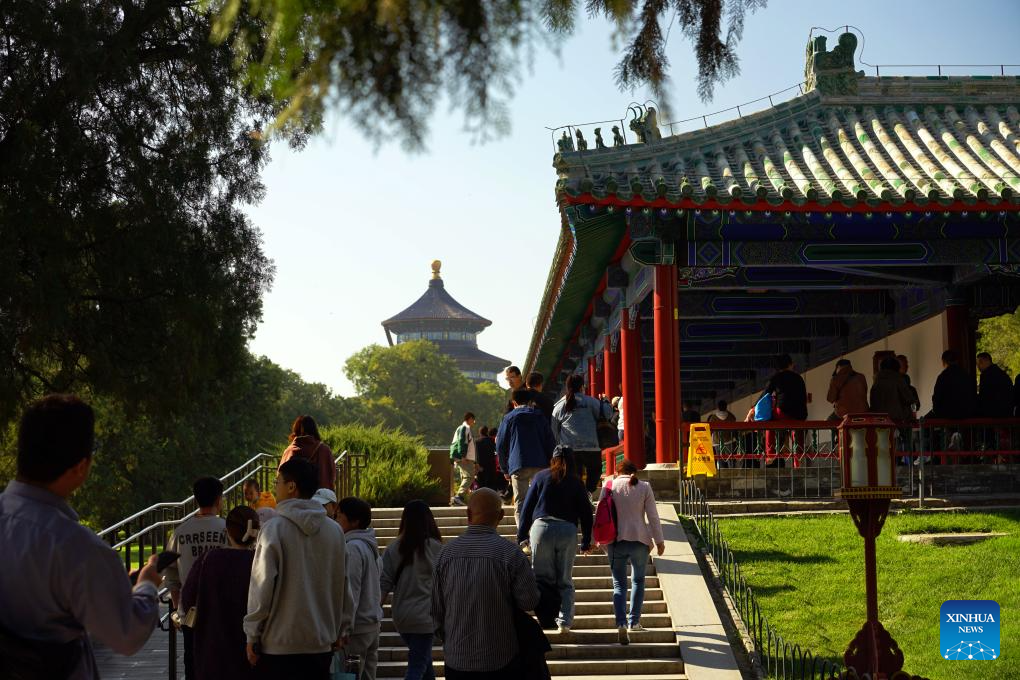
This photo taken on Oct. 22, 2023 shows people visiting the Temple of Heaven, which was listed as one of the UNESCO world heritage sites in 1998, on the Beijing Central Axis in Beijing, capital of China. First created in the Yuan Dynasty (1271-1368), the Beijing Central Axis, or Zhongzhouxian, stretches 7.8 km between the Yongding Gate in the south of the city and the Drum Tower and Bell Tower in the north. Most of the major old-city buildings of Beijing sit along this axis.
Chinese authorities have planned to recommend the Beijing Central Axis as China's 2024 world cultural heritage application project. It was included on the preliminary list of China's world cultural heritage sites in 2012. (Xinhua/Mu Wenchun)
Photos
Related Stories
- Ethiopian Ulfata, Kenyan Chepkirui win at 2023 Beijing Marathon
- Autumn scenery of Great Wall in China
- 10th Beijing Xiangshan Forum to open Sunday
- Beijing's Daxing airport handles over 30 mln passenger trips this year
- Soak in the vibes of Beijing with a Central Axis city walk
- Beijing to welcome 12.8 million tourists during upcoming holiday
- Beijing airports expect surge in passenger throughput during upcoming holidays
- Floral displays adorn Beijing for Mid-Autumn Festival, National Day holiday
- Beijing leads Chinese cities in extending rail transit lines
- "Hello, Beijing" photography exhibition showcases beauty of Beijing in Qatar
Copyright © 2023 People's Daily Online. All Rights Reserved.






